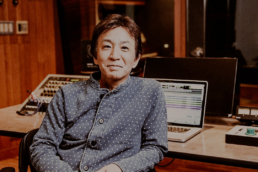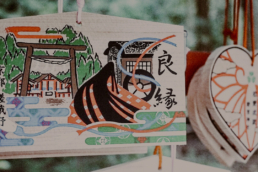Emoji e cultura giapponese: il linguaggio visivo che conquista il mondo
Le emoji sono diventate un elemento essenziale della comunicazione digitale. Questi piccoli simboli colorati arricchiscono messaggi, post e campagne pubblicitarie, trasformando semplici parole in espressioni più vive ed emozionali. Ma dietro a queste icone c’è molto più di quanto sembri: le emoji hanno radici profonde nella cultura giapponese e comprenderne il significato può rendere la comunicazione più efficace e coinvolgente.

L'origine giapponese delle emoji
Alla fine degli anni '90, il Giappone era all’avanguardia nelle telecomunicazioni mobili. Per rendere i messaggi più espressivi e sintetici, vennero introdotte le prime emoji, un’idea che combinava l’estetica minimalista giapponese con la necessità di comunicare emozioni in modo immediato. Il termine stesso, "emoji", deriva da "e" (immagine) e "moji" (carattere), evidenziando la loro funzione di simboli visivi.
Le emoji e la cultura giapponese
Molte delle icone che utilizziamo quotidianamente sono direttamente ispirate alla tradizione giapponese. Il ramen 🍜, il torii ⛩ (il portale rosso dei santuari shintoisti), il dango 🍡 (dolce di riso su stecco) o il naruto 🍥 (guarnizione a spirale per il ramen) sono solo alcuni esempi di emoji che riflettono la cultura e la cucina del Giappone. Questi simboli non sono semplici decorazioni, ma raccontano storie e tradizioni, aggiungendo profondità alla comunicazione digitale.
L’uso delle emoji nel marketing
Le emoji sono strumenti potenti per il marketing, capaci di abbattere le barriere linguistiche e creare connessioni immediate con il pubblico. Tuttavia, il loro significato può variare in base al contesto culturale. Alcuni gesti e simboli, infatti, possono essere interpretati in modi diversi a seconda del Paese. Per questo motivo, chi utilizza le emoji nella comunicazione deve considerare con attenzione il target di riferimento, evitando fraintendimenti e rendendo il messaggio più autentico e inclusivo.

Consigli per un uso efficace
Per sfruttare al meglio le emoji nella comunicazione, è utile seguire alcune linee guida:
✔ Conoscere il pubblico per scegliere emoji comprensibili e adatte al contesto.
✔ Mantenere coerenza con il brand, utilizzando simboli che riflettano il tono e i valori dell’azienda.
✔ Evitare gli eccessi, affinché il messaggio rimanga chiaro ed efficace.
✔ Rimanere aggiornati sulle nuove emoji e sulle tendenze emergenti per una comunicazione sempre attuale.
Un linguaggio universale in continua evoluzione
Le emoji non sono semplici elementi decorativi, ma veri e propri strumenti di espressione che arricchiscono la comunicazione digitale. Comprendere le loro origini e il loro significato permette di utilizzarle in modo più consapevole, trasformandole in un ponte tra culture diverse e in un elemento chiave per strategie di marketing più efficaci e coinvolgenti.
Sakè: tre curiosità sulla bevanda simbolo del Giappone
Il sake non è semplicemente un alcolico: è un autentico pezzo di cultura giapponese, strettamente legato alla storia, alle tradizioni e persino alla spiritualità del Paese del Sol Levante. Sebbene venga spesso definito "vino di riso", la sua produzione è tutta speciale e il suo significato va ben oltre il semplice gusto. Per parlare delle bevande a base di riso, l'ideogramma sake [酒] si riferisce in generale all'alcool, ma viene pronunciato shu. Quando i giapponesi parlano di bevande realizzate con il riso, usano il termine nihonshu [日本酒], che significa "bevanda del Giappone".
E ora, preparatevi a scoprire tre curiosità affascinanti che vi faranno vedere il sake sotto una luce completamente nuova!

1. Il sake non è un distillato
Molti credono che il sake sia simile ai liquori o ai distillati, ma in realtà il suo processo di produzione è più vicino a quello della birra. Il riso utilizzato viene prima levigato per eliminare le impurità, poi cotto a vapore e fatto fermentare grazie a un fungo speciale chiamato koji. Questo trasforma gli amidi in zuccheri, permettendo al lievito di avviare la fermentazione alcolica.
Il risultato? Una bevanda dal gusto complesso e delicato, con una gradazione alcolica che si aggira tra il 13% e il 16%. E se pensavate che esistesse solo un tipo di sakè, ripensateci: ne esistono varianti più leggere, non filtrate, frizzanti e persino invecchiate!

2. Un legame con il sacro
Il sake non è solo un piacere per il palato, ma anche un elemento profondamente radicato nelle tradizioni religiose giapponesi. Antiche leggende narrano che persino gli dèi lo apprezzavano: si dice che il dio delle tempeste Susanoo-no-Mikoto abbia sconfitto un drago offrendogli otto barili di sake.
Ancora oggi, questa bevanda viene usata nei rituali shintoisti, specialmente nei matrimoni e nelle offerte ai kami (le divinità giapponesi). Durante alcuni festival, come il Doburoku Matsuri, viene distribuito un sakè non filtrato ai partecipanti, creando un legame tra il sacro e la convivialità.

3. Il galateo del sake
Non basta riempire un bicchiere e bere, il sake ha un vero e proprio codice di comportamento. Tradizionalmente si beve in piccole tazzine di ceramica (choko) o in eleganti scatoline di legno (masu). Ma la regola d’oro è una: mai versarselo da soli! È un gesto poco educato, mentre versarlo agli altri è un segno di rispetto e condivisione.
Anche la temperatura conta: d’inverno si può gustare caldo, mentre nei mesi estivi è più apprezzato fresco o persino freddo. Ogni metodo di servizio esalta aromi diversi, rendendo ogni sorso un’esperienza unica.
Un brindisi alla tradizione!
Il sake non è solo una bevanda, è un viaggio nella cultura giapponese. La prossima volta che avrete l’occasione di assaggiarlo, ricordatevi di alzare la tazzina e brindare con un tradizionale "Kanpai!" – e magari stupire i vostri amici con queste curiosità!
Il nostro rapporto con il Sake
Japan Italy Bridge si è spesso dedicata alla promozione del sake, portando avanti numerose iniziative, tra cui la Bunka Academy. L’obiettivo è stato quello di far conoscere anche in Italia la consapevolezza di come apprezzare il sake, sottolineando che non si tratta di una grappa, ma di un vero e proprio vino. Non è una bevanda da consumare solo a fine pasto, ma da gustare durante tutta la cena. A differenza del vino, il sake non copre i sapori dei piatti, ma li esalta. Per questo motivo, Japan Italy Bridge ha organizzato eventi in collaborazione con esperti giapponesi, che hanno condiviso con il pubblico la storia, il processo di produzione e i segreti del consumo e della conservazione del sake.
Se siete curiosi, vi invitiamo a dare un’occhiata al nostro portfolio e scoprire tutte le collaborazioni che abbiamo portato avanti.
L'Artista Dimenticato di Osaka: La Magia di Nakamura Hōchū
Quando si parla della scuola artistica Rinpa, spesso si pensa ai grandi nomi di Kyoto, ma c'era un artista che riuscì a far brillare questo stile anche a Osaka: Nakamura Hōchū. La sua vita resta avvolta nel mistero, ma ciò che è certo è che fu un innovatore capace di reinterpretare la tradizione con un tocco tutto suo.
Hōchū iniziò la sua carriera immerso nell'ambiente culturale di Osaka, una città vivace e ricca di stimoli artistici. Inizialmente influenzato dallo stile Nanga, amava frequentare poeti e letterati, tra cui Kimura Kenkadō, con cui condivideva la passione per la bellezza e la natura. Ma il vero punto di svolta arrivò quando scoprì le opere di Ogata Kōrin, uno dei grandi maestri della scuola Rinpa. Fu amore a prima vista: i colori vibranti, le forme eleganti e la composizione raffinata conquistarono Hōchū, che decise di dedicarsi a questo stile, reinterpretandolo in maniera originale.

Photos: Wikipedia
La sua opera più celebre, il "Kōrin Gafu", è una vera e propria celebrazione del Rinpa. Si tratta di un libro illustrato che raccoglie dipinti di fiori, paesaggi e scene di vita quotidiana, realizzati con un'eleganza e una leggerezza straordinarie. Ma a differenza dei suoi predecessori, Hōchū aggiungeva un tocco giocoso e spontaneo alle sue creazioni, rendendole più accessibili e dinamiche. Il suo stile, pur rispettando i canoni del Rinpa, aveva una freschezza che lo distingue ancora oggi.

Photos: Wikipedia
Ciò che rende affascinante Hōchū è proprio questa sua capacità di essere fedele alla tradizione senza risultare ripetitivo. Le sue opere sembrano quasi dialogare con lo spettatore, raccontando storie attraverso linee fluide e colori vivaci. Non è un caso che i suoi lavori siano finiti nelle collezioni di importanti musei internazionali, dove continuano a incantare appassionati d'arte e studiosi.
Oggi, il nome di Nakamura Hōchū potrebbe non essere tra i più conosciuti quando si parla di arte giapponese, ma il suo contributo alla diffusione dello stile Rinpa è stato fondamentale. La sua capacità di innovare senza stravolgere, di rendere moderno un linguaggio artistico antico, lo rende un artista da riscoprire e ammirare. Se vi capita di vedere una sua opera, fermatevi a osservarla con attenzione: potreste scoprire un lato inaspettato dell'arte giapponese.
Hosokawa Tadaoki: Un Guerriero e Stratega del Giappone Feudale
Hosokawa Tadaoki (1534-1596) è stato uno dei più noti samurai del periodo Sengoku, un’epoca caratterizzata da conflitti intensi e lotte per il potere in Giappone. Figlio di Hosokawa Ujitsuna, un potente daimyo, Tadaoki si distinse per il suo talento militare e il suo ruolo strategico, guadagnandosi rispetto e influenza durante la transizione dal periodo Sengoku al periodo Edo.

Photo: Wikipedia
Tadaoki iniziò la sua carriera militare come giovane samurai al servizio del clan Hosokawa. Sebbene il suo nome sia più noto per il suo legame con il celebre leader militare Toyotomi Hideyoshi, la sua lealtà a quest’ultimo fu fondamentale per il suo successo. Nel 1582, dopo la morte di Oda Nobunaga, Tadaoki si unì alle forze di Hideyoshi, partecipando alla campagna che portò alla sottomissione di gran parte del Giappone.
Una delle azioni più note di Hosokawa Tadaoki fu la sua partecipazione alla battaglia di Shizugatake (1583), in cui, nonostante fosse schierato contro l’alleato di Nobunaga, il generale Mori Terumoto, riuscì a prevalere grazie a una manovra strategica impeccabile. Questo successo gli consentì di ottenere maggiori terre e potere.
Tadaoki non era solo un guerriero, ma anche un abile stratega. La sua capacità di adattarsi rapidamente ai cambiamenti sul campo di battaglia lo rendeva un alleato indispensabile per Hideyoshi. Tuttavia, la sua figura si distinse anche per il suo interesse per la cultura, specialmente la cerimonia del tè, dove divenne un mecenate delle arti e un importante influente nella corte.
Dopo la morte di Hideyoshi, Tadaoki continuò a esercitare la sua influenza, mantenendo il controllo delle sue terre e cercando di navigare tra le tensioni politiche che avrebbero portato alla nascita dello shogunato Tokugawa. La sua morte nel 1596 segnò la fine di un’epoca, ma il suo nome è rimasto nel cuore della storia giapponese come simbolo di lealtà, coraggio e saggezza strategica.
Tokyo e gli incroci: Non solo Shibuya Scramble
Immaginate di essere immersi nella vibrante e dinamica Tokyo, un luogo dove ogni angolo riserva una sorpresa e ogni strada racconta una storia. L'incrocio di Shibuya è forse l'epicentro di questa energia travolgente, un simbolo iconico immortalato in innumerevoli scatti. Qui, gli imponenti edifici commerciali, le sfavillanti insegne pubblicitarie e la fiumana incessante di pedoni creano un'atmosfera unica, quasi magica. Ma se il vostro desiderio è esplorare angoli meno conosciuti, altrettanto affascinanti, ecco cinque incroci di Tokyo che vi faranno innamorare di questa città ancora di più.

Credits: Savvytokyo
Sukiyabashi Crossing
Il primo è il Sukiyabashi Crossing a Ginza, una vera gemma nascosta che offre un'esperienza visiva e sensoriale simile a Shibuya. Le linee pedonali bianche e ordinate, insieme alla vitalità del Ginza Sony Park e del Sukiyabashi Park, creano un'atmosfera futuristica e vibrante. Ma ciò che rende davvero speciale questo incrocio è la maestosa Tokyu Plaza Ginza, con la sua facciata ispirata al vetro Edo Kiriko. Conosciuto come la "Porta di Ginza", questo luogo definisce l'eleganza e il lusso del quartiere dello shopping di Tokyo.

Credits: A. Wee
Nissan Crossing
Proseguendo nel cuore di Ginza, vi troverete all'incrocio della Seiko House Ginza. Questo punto evoca il glamour della Fifth Avenue di New York, con le sue vetrine scintillanti e l'architettura raffinata. Qui, il lusso giapponese è palpabile: da un lato, i sofisticati orologi Seiko; dall'altro, le auto all'avanguardia di Nissan e l'innovativo showroom Sony. Ogni angolo trasuda eleganza e artigianato di altissimo livello.

Credits japantravel.navitime.com
Roppongi Crossing
Spostandoci a Roppongi, troviamo un incrocio che brilla soprattutto di notte. Le luci dei grattacieli illuminano il cielo, creando un'atmosfera incantata. Roppongi Crossing è attraversato dalla Metropolitan Expressway, una struttura imponente che aggiunge un tocco di grandiosità urbana. I segnali "Roppongi" sulla superstrada sono un riferimento inconfondibile, un simbolo di questo quartiere vivace e cosmopolita. Quando siete in zona, non perdete l'occasione di visitare uno dei tanti bar alla moda di Roppongi.

Credits B.Lucava
Kabukicho Crossing
Un altro incrocio imperdibile è quello di Kabukicho a Shinjuku. Qui, la testa di Godzilla che spunta dal Toho Cinema regala una scena surreale e iconica. Kabukicho è il cuore pulsante della vita notturna di Tokyo, con le sue insegne al neon, i ristoranti e i bar affollati di studenti e salarymen. Questo quartiere a luci rosse, con il suo mix di cultura pop e vivace energia, offre infinite opportunità fotografiche e un'esperienza unica.

Credits J. Jenkin
Asakusa Crossing
Infine, non possiamo dimenticare l'incrocio di Asakusa, che segna l'ingresso a Nakamise-dori e conduce al maestoso Tempio Sensoji. Questo è uno dei panorami più riconoscibili di Tokyo, dominato dalla Porta Kaminarimon con la sua imponente lanterna. L'atmosfera qui è impregnata di storia e tradizione, arricchita dai risciò che attendono i turisti all'ingresso. Attraversando la strada, troverete il Centro informazioni turistiche della cultura Asakusa, progettato da Kengo Kuma, da cui potrete godere di una vista mozzafiato sull'area circostante.
Questi incroci rappresentano l'essenza di Tokyo, una città che sa sorprendere e affascinare con ogni suo angolo. Preparatevi a scoprire la magia che si cela in queste meraviglie urbane e lasciatevi ispirare dalla loro bellezza unica.
Gli Anime: una forma d’arte senza tempo
Quanti di noi sono cresciuti guardando i “cartoni animati” (come eravamo ignorantemente soliti definirli) di “Dragon Ball”, “Capitan Tsubasa”, “Sailor Moon”, “La Rosa Di Versailles” e quanti più ne ha ne metta!? Ora che abbiamo qualche (molti!) anni in più possiamo approfondire il concetto e capire cosa rappresentano veramente per il Sol Levante.
Queste serie animate sono caratterizzate da una vasta gamma di generi, stili e temi ed è una vera e propria forma d'arte che ha radici profonde nella cultura giapponese e si è evoluta nel corso del tempo, diventando un pilastro dell'intrattenimento sia in patria che all'estero. Non sono solo un mezzo di divertimento, ma spesso trattano tematiche complesse e universali, offrendo riflessioni sulla società, la politica e le relazioni umane. La loro importanza risiede nella capacità di trasmettere emozioni, raccontare storie coinvolgenti e esplorare concetti complessi attraverso un medium accessibile e visivamente stimolante.

Credits anime.everyeye.it
Patrimonio globale
L'internazionalizzazione è un fenomeno significativo che ha reso gli anime una parte integrante della cultura popolare globale. Negli ultimi decenni, hanno conquistato un vasto pubblico al di fuori del Giappone, con una fanbase sempre più ampia in tutto il mondo. Ciò è stato facilitato da diversi fattori:
- piattaforme come Netflix, Crunchyroll e Funimation gli hanno resi facilmente accessibili in molte parti del mondo, consentendo agli spettatori di guardare le ultime serie con sottotitoli o doppiaggio in diverse lingue.
- social media e comunità online hanno giocato un ruolo fondamentale nell'espandere il fanbase degli anime. Reddit, X e Discord hanno dato agli appassionati uno spazio per discutere, condividere fan art, teorie e notizie, contribuendo a creare un senso di comunità globale.
- Le convention dedicate si tengono in tutto il mondo, offrendo ai fan l'opportunità di incontrarsi di persona, partecipare a panel, concorsi di cosplay e acquistare merchandise esclusivo.
Merchandise per tutti i gusti
Il successo internazionale ha anche generato un vasto mercato di prodotti come giocattoli e action figures che riproducono personaggi iconici; abbigliamento e accessori come t-shirt, felpe, cappellini e i gadget per la casa: tazze, poster, cuscini e tantissimi altri oggetti.
Inoltre non dobbiamo dimenticare il fiorente mercato dei videogames: molti anime hanno ispirato videogiochi per console e dispositivi mobili, che permettono ai fan di immergersi ulteriormente nei mondi delle loro serie preferite.

Credits: voyapon.com
Il sostegno del governo nazionale
Il governo giapponese ha giocato un ruolo significativo nel sostenere l'industria degli anime attraverso politiche e incentivi finanziari, riconoscendo l'importanza economica e culturale del settore fornendo finanziamenti diretti e agevolazioni fiscali alle aziende che producono anime, al fine di promuovere la produzione e la distribuzione di contenuti di alta qualità, inoltre il governo stesso collabora con enti come la Japan Foundation e il Japan External Trade Organization (JETRO) per promuovere gli anime all'estero. Non meno imporntate è il forte impegno nella protezione della proprietà intellettuale attraverso la quale il governo lavora per proteggere i diritti d'autore e combattere la pirateria, garantendo che le aziende e gli artisti che producono anime ricevano un equo compenso per il loro lavoro.

Credits: gurneyjourney.blogspot.com
Una crescita senza confini
Stile unico e ricca narrazione fanno degli anime un tesoro globale che però non deve perdere le proprie radici: questa è una sfida costante soprattutto culturale. Nel nostro Paese gli anime trasmessi normalmente in televisione sono censurati, nella versione originale sono incluse espressioni violente o satira, che possono sollevare aperti dibattiti. Nonostante questo però, le società di produzione di anime devono trovare un equilibrio tra libertà artistica e sensibilità culturale e proseguire nel loro stile unico e inimitabile.
Voi cosa ne pensate?
Viaggia con noi
Japan Italy Bridge ha appena lanciato il suo esclusivo “Your Japan”, un viaggio in Giappone costruito su misura per i turisti italiani. Per questo autunno, avrete la possibilità di andare con noi a Tokyo. Un’esperienza All Inclusive che vi permetterà di scoprire le bellezze della capitale del Giappone. Japan Italy Bridge si occuperà di tutto, dalla prenotazione di voli ed hotel, sino alla programmazione del piano di viaggio. Inoltre, le nostre guide partiranno con voi dall’Italia e vi accompagneranno lungo tutto il percorso nipponico.
Quindi cosa state aspettando? E’ arrivato il momento di fare la valigia e partire con noi!
Il potere dei social: TikTok e la pop star giapponese
Continuiamo con la nostra rubrica Business Focus e oggi trattiamo del caso TikTok e Miki Matsubara. Sapete già di cosa stiamo parlando?
Abbiamo già detto molte volte come i social media siano una potenza sia per le aziende che per i privati e in questo anno di pandemia ne abbiamo avuto la conferma. Anche chi non credeva nella rivoluzione digitale ora si è dovuto ricredere.
Come TikTok ha riportato in auge una pop star giapponese
Autore: Erika
In questi mesi di quarantene ed isolamento forzato, abbiamo visto un incremento della creatività sui social media. Esempio palese di questo è la veloce ascesa di TikTok, social media prediletto dai giovani che ha visto crescere i suoi scritti sino ad arrivare ad essere la seconda app più scaricata nel 2020.
Dagli scherzi, agli animali passando per gli ormai famosi balletti, molti TikTokers hanno lanciato mode che ancora oggi accompagnano le nostre giornate. Ma oggi il potere di TikTok non si ferma soltanto ai suoi trend. Ha fatto scalpore infatti il caso di Miki Matsubara e di come un video condiviso su questo social sia riuscito a riportare in auge una sua hit del 1979.
A dicembre infatti, gli utenti della piattaforma hanno resuscitato la canzone "Mayonaka no Door: Stay With Me" che aveva reso Matsubara una star in Giappone già nel 1979. Più di quarant'anni dopo, la canzone è ancora orecchiabile e gioisa tanto da diventare la perfetta colonna sonora di un TikTok con protagonista le mamme giapponesi.
"Ho fatto il TikTok quando mia mamma stava facendo delle cose in casa", dice un utente a The Japan Times via mail. Questa clip ha raggiunto più di 1,5 milioni di like e visualizzazioni in pochissimo tempo facendo schizzare "Mayonaka no Door" in cima alla classifica Global Viral 50 di Spotify per tre settimane.
@kickronnie
I’m asking her to sing this next karaoke night 👸🏻 #japan #japanese #おかあさま #fyp
♬ 真夜中のドア/Stay With Me - Miki Matsubara
Sfortunatamente, Matsubara è morto nel 2004 e non ha potuto godere della rinascita. Tuttavia, il compositore della canzone, il 71enne Tetsuji Hayashi, dice al Japan Times che questo nuovo successo "sembra molto strano... è stato così tanto tempo fa".
La musica e i social media
Ma è davvero così strano? Partendo dal fatto che quando una canzone è bella, è bella sempre anche dopo quarant'anni, ma pensiamo anche a quanto potere abbiano acquistato al giorno d'oggi i social media. Purtroppo, gran parte dell'industria musicale giapponese sembra ancora operare come se fosse il 1979, dando quindi poca importanza al mondo digital e dei social media. Il caso Matsubara ne è un esempio.
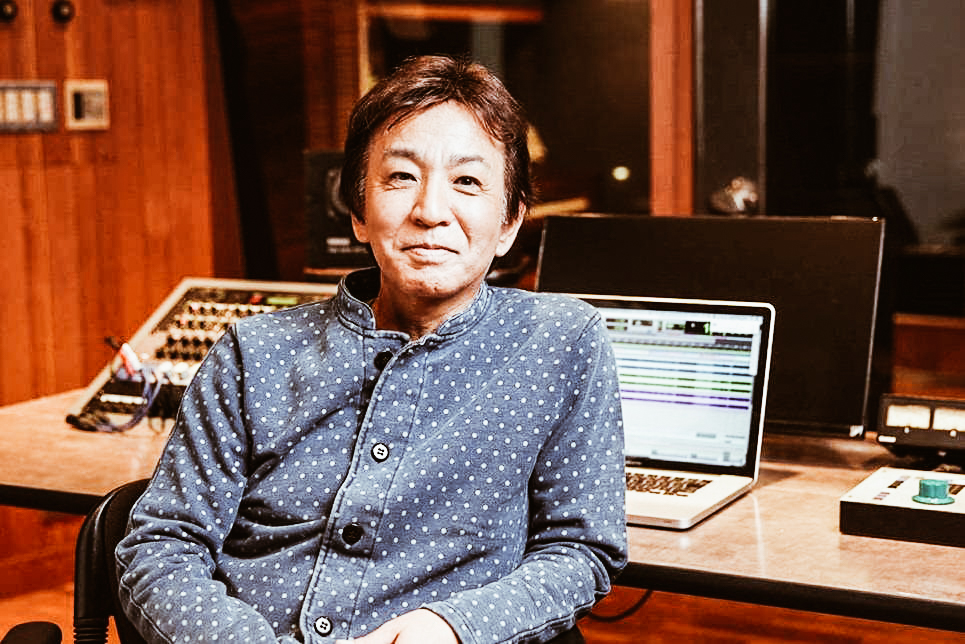
Il cantautore Tetsuji Hayashi dice che le nuove tecnologie stanno riscrivendo le regole di come una canzone diventa una hit, "potrebbe essere di un altro paese o di un'altra generazione". Ormai sono già passati alcuni mesi ma il caso "Mayonaka no Door" mostra come l'interazione fra artisti giapponesi e ascoltatori internazionali sia cambiata negli ultimi decenni. I social media internazionali permettono anche ad una nuova generazione di innamorarsi di un'artista che in passato avrebbe potuto essere scartata dalle playlist solo a causa della sua nazionalità. Complice anche l'ascesa del K-pop e degli ormai instoppabili BTS, sui social media come TikTok troviamo sempre più anche trend di canzoni giapponesi.
Il potere di TikTok

Basandosi sulle recenti statistiche, gli utenti di TikTok trascorrono più di 850 minuti al mese sull'app, ovvero più di 14 ore al mese. Se esaminiamo i dati da ottobre 2019 a marzo 2020, possiamo notare un notevole aumento del tempo che l'utente medio trascorre sull'app, complice appunto anche il lockdown.
Questo social media si è diffuso a macchia d'olio a livello mondiale, in particolare nelle nazioni asiatiche, diventando un outlet per l'intrattenimento anche grazie alla sua ricerca di Hashtag. Infatti, a giugno 2020, le categorie più popolari su TikTok hanno tutte più di un miliardo di visualizzazioni. Se andiamo a contare i video di lip-synching e quelli sulla danza, arriviamo un totale di oltre 150 miliardi di visualizzazioni.
Il 2020 è stato un anno segnato dai lockdown ed è proprio in questo periodo che le persone si sono buttate sui nuovi media in cerca d'intrattenimento e di sfogo per la propria creatività. Infatti, TikTok ha conquistato il secondo posto nella classifica delle app più scaricate per iPhone superata solo da Zoom per ovvi motivi. TikTok ha addirittura superato i download di Facebook, Messenger, Gmail, Netflix, YouTube e Instagram, su tutti gli app store, diventando così l'app più popolare in assoluto a livello globale nel 2020.
Inoltre, in un modo come quello del digital marketing, sappiamo quanto sia importante il tasso di coinvolgimento di un social media. I recenti dati mostrano come l'engagement rate vari a diversi livelli di followers per Instagram, YouTube e altri social. Tuttavia, a tutti i livelli di follower, TikTok ha un tasso considerevolmente più alto rispetto alle altre piattaforme. Infatti, Upfluence ha analizzato che i micro-influencer hanno un tasso di coinvolgimento del 17,96% su TikTok, a paragone del 3,86% su Instagram e dell'1,63% su YouTube. Mentre i mega-influencer hanno un tasso di coinvolgimento del 4,96% su TikTok, 1,21% su Instagram e 0,37% su YouTube.
I dati parlano da soli e anche in questo 2021 non possiamo che aspettarci una costante ascesa di questo social e chissà, forse potremo riscoprire qualche altra hit giapponese! Avete già qualche idea su quale potrebbe essere il prossimo music trend degli TikTokers in questo 2021?
Le tavolette Ema e i templi del Giappone
Continua la rubrica di Japan Italy Bridge per promuovere gli approfondimenti legati al mondo del Giappone, oggi parliamo di delle Tavolette Ema che troviamo in tutti i templi del Giappone.
Alzi la mano chi in qualche anime non ha mai visto queste curiose targhette di legno. Magari in un santuario shinto, con una miko – la sacerdotessa vestita di rosso e bianco – alle prese con le sue faccende. In ogni caso, che le abbiate già viste o meno, oggi potrete saperne di più.
Ema 絵馬 Le tavolette votive in legno giapponesi
Autore Ospite: Flavia
Traducibile come “Raffigurazione di cavallo”, le Ema sono targhette piatte concepite per trascriverci desideri e paure da rivolgere a dei/spiriti (kami) e buddha. In altre parole, rappresentano un modo tramite cui le persone possono scrivere un messaggino con destinazione mondo spirituale. Anticamente in argilla, hanno poi iniziato ad essere realizzate in legno. Una volta scritta la propria preghiera, l’Ema va appesa in uno spazio dedicato presso santuari shintoisti ma anche templi buddhisti. Si tratta infatti di una consuetudine di origine shinto estesasi poi anche ai templi. Essendo esposte tutte assieme “pubblicamente”, chiunque naturalmente può darci una sbirciatina (importante è che siano anche i kami a farlo).
È però anche possibile tenersele per sé, a mo’ di cimelio. La grande varietà di rappresentazioni, colori e stili che le caratterizza, attira da sempre la curiosità dei folkloristi. Insieme alle iscrizioni in esse riportate rappresentano un vero e proprio prisma, attraverso cui una vasta gamma di storie di vita ci viene presentata. Uno spaccato di spiritualità che può mostrarci i diversi colori della realtà giapponese.
Le Ema non sono gli unici oggetti religiosi pensati per ‘operare’ in tal senso ma sono forse quelle più diffuse, presenti appunto un po’ ovunque. Il fatto di poterle lasciare sul posto, le caratterizza rispetto ad altri oggetti religiosi quali Fuda (札) e O-Mamori (お守り). Larghe in media 15 cm e alte 9 cm, possono tuttavia presentare grandezze ma anche forme e colori molto variegati.
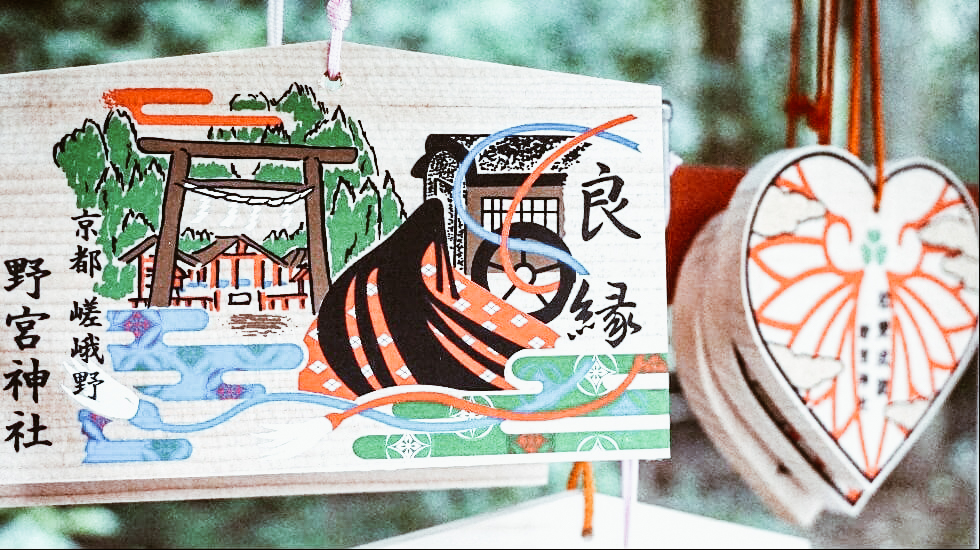
photo credits: sharing-kyoto.com/
I temi raffigurati possono spaziare fra i seguenti:
- il kami/buddha cui santuario o tempio sono dedicati (addirittura possono esistere tavolette raffiguranti Thomas Edison!);
- i benefici specifici che kami (神 spiriti/divinità) e buddha hanno facoltà di donare;
- scene su origine e storia del luogo di culto;
- soggetti religiosi o culturali, come gli animali dello zodiaco di origine cinese (alcuni santuari sono specificamente dedicati ad un animale-segno dello zodiaco)
Tuttavia, tradizionalmente, particolare rilievo assume la raffigurazione del cavallo, come d’altronde suggerisce l’etimologia del nome stesso: e (絵) “immagine, disegno”, ma (馬) “cavallo”.
Perché il cavallo?
Risposta breve: perché nell’antichità si usava offrire un cavallo a santuari e templi per ottenere benedizioni o comunque propiziarsi la buona sorte. La figura del ‘cavallo sacro’ sopravvive ancora ai nostri giorni, tant’è che alcuni centri religiosi usano tenerne uno. E, se non in carne ed ossa, sotto forma di modello a grandezza naturale.
Questa sacralità del cavallo ha origine da un’antica credenza shinto che vedeva nel cavallo un animale caro ai kami nonché un loro messaggero (sebbene sia importante anche nel buddhismo). Da cosa nasce cosa quindi, ed ecco che l’equino diviene presto simbolo portatore di messaggi fra il mondo umano e “l’altra Sponda”. O l’Higan (彼岸) come viene chiamato anche nell’anime/manga Noragami. (Noragami è consigliatissimo se siete attratti dal genere, per così dire, ‘spirituale’. Pur attraverso l’interpretazione di fantasia dell’autore, vi dà uno spaccato religioso del Giappone, e rende molto bene il rapporto dei giapponesi con la spiritualità.)
Ad ogni modo, appurato che il nostro cavallo era considerato speciale, l’idea era di invocare una “mano dal cielo” in situazioni o eventi problematici. Ad esempio, in tempi di siccità in cui si sperava in un po’ di pioggia (cavallo nero) o, caso contrario, affinché smettesse di piovere (cavallo bianco). Tuttavia in tempi antichi solo pochi potevano permettersi di dare via facilmente un cavallo. La maggioranza delle persone cercava di tenerselo stretto, poiché animale prezioso per il proprio sostentamento. Per altro, come nota l’accademico Ian Reader, tali offerte potevano rivelarsi dispendiose anche per i templi se, a ogni preghiera di qualche ricco signore, si ritrovavano ogni volta con un cavallo, che giustamente doveva essere mantenuto, con le spese che ciò comportava.
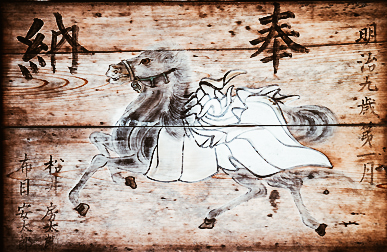
photo credits: japan-photo.de
È proprio in risposta a tali problemi contingenti che l’idea della raffigurazione del cavallo inizia a fare capolino. Anziché adoperare l’animale in carne ed ossa: perché invece non realizzare delle “e-ma” (“immagine-cavallo”)? Una soluzione conveniente, accessibile a tutti.
Le Ema fanno così la loro prima comparsa a inizio VIII secolo (periodo Nara), mentre le prime testimonianze ci giungono dalla metà del X secolo (periodo Heian). Sarebbe la raccolta di poesie e prosa cinesi Honchō Bunsui o Monzui ( 本朝文粋 ) la primissima opera a parlare delle “ema”. Cui seguiranno molte altre, una fra tutte, il Konjaku monogatari (今昔物語).
E·ma: le origini delle tavolette
Le Ema sarebbero perciò nate come sostitutivi del cavallo, nell’atto di far pervenire le proprie preghiere alle supreme entità ultraterrene. Sebbene non sia mancata qualche vocina contraria rispetto a tale linea generale. Un’altra lettura degli avvenimenti vorrebbe infatti che le targhette abbiano assunto la definizione “ema”, semplicemente, per una maggiore diffusione del disegno del cavallo rispetto ad altri temi.
Questo perché il tema del disegno cambiava a seconda della richiesta. Mettiamo che il disegno di una Ema fosse quello di un cavallo: il desiderio del richiedente poteva riguardare il benessere del proprio cavallo (pensiamo al caso dei più umili, per cui tale animale era fondamentale). Se il desiderio non riguardava un cavallo ma, ad esempio, un malanno fisico il disegno avrebbe ritratto la parte del corpo dolorante; e così via. Dunque “ema” secondo tale visione non indicherebbe che alle tavolette sia stata attribuita la stessa “agency” dell’animale. Bensì che semplicemente vi erano molte richieste riguardanti i cavalli, da cui poi sarebbe scattata un’estensione della denominazione.
Un’altra interpretazione invece sottolinea come la sacralità del cavallo non sia un’invenzione meramente shintoista e come anche nel Buddhismo l’animale abbia un suo peso. Quindi, che l’origine delle Ema sarebbe forse più da ricercarsi ripensando al ruolo del Buddhismo, cui le tradizioni popolari giapponesi attingono ampiamente. A tal proposito lo studioso Gorai Shigeru ha visto in una particolare usanza popolare, relativa alla tradizione buddhista O-Bon (お盆), una possibile origine delle Ema. Tale usanza consiste nel ricavare forme di cavallo da certi vegetali, sempre a scopo votivo, verso le anime dei morti. Gorai sembrerebbe insinuare il dubbio che l’origine di tale usanza possa essere precedente rispetto a quella attribuita alle Ema o ad altre forme simili di rappresentazione.
Entrambi tali voci dissonanti, circa le origini delle Ema, sembrano non trovare grande riscontro nell’archeologia. I ritrovamenti archeologici sembrerebbero infatti confermare tutti l’ipotesi della necessità di un mezzo alternativo al cavallo, che contemporaneamente ne facesse ‘le veci’. Un qualcosa di equivalente, che ne incarnasse lo spirito, un suo simbolo: la sua immagine.
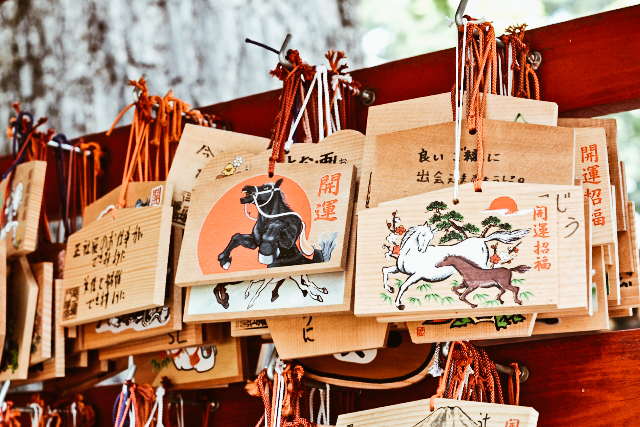
photo credits: shrine-temple-navi.jp
Ema come “oggetti viventi”
La prova di ciò giungerebbe dalla lingua stessa. Vi sono numerose antiche iscrizioni su Ema che, da un punto di vista linguistico, inequivocabilmente si riferiscono alle tavolette come se stessero parlando del cavallo stesso. Vediamone alcune.
Nel sopra citato Honchō Bunsui infatti comparirebbe un riferimento alle Ema contenente il simbolo 匹 (“hiki”, “biki” o “piki”). Riportando dal Reader, l’espressione sarebbe: “色紙絵馬三匹 ”ovvero“ 3 fogli colorati di immagini di cavallo”. Oggigiorno usato come contatore per piccoli animali, nel giapponese antico l’ideogramma 匹designava invece animali da stalla, fra cui i cavalli. L’accostamento della parola “ema” a tale particella linguistica, la cui funzione è quella di designare appunto un essere vivente, la dice lunga. Iscrizioni simili sono state rinvenute anche in due santuari a Yamagata e Saitama, risalenti a XVI e XVII secolo. In questo caso troviamo l’ideogramma 疋 invece di 匹, ma significato e lettura sono i medesimi. Riportando sempre da Reader, si tratta di: “shinme ippiki” (神馬一疋) e “ema ippiki” “ 絵馬一疋 ”. Ossia “un cavallo sacro” e “una immagine di cavallo”.
Comunque, per quanto l’ipotesi sulla possibile origine buddhista delle tavolette non fosse solida, il Buddhismo almeno a posteriori è certamente compresente, considerato il sincretismo giapponese. Tra l’altro nei templi, le Ema fungono da mezzo per trasmettere la dottrina religiosa buddhista, assumendo così un’ulteriore funzione oltre quella per cui sono nate. Parliamo di quegli insegnamenti circa l’importanza dell’altruismo o della compassione (intesa nel buddhismo come ‘empatia’) o attraverso immagini tratte dai racconti sul Buddha. Sebbene non del tutto certo, si stima che l’adozione delle tavolette da parte dei templi buddhisti sia iniziata grossomodo fra XII e XIV secolo (periodo Kamakura). Infatti molti degli Emaki – opere d’arte a rotolo – dell’epoca ritraggono le Ema o i cavalli stessi, sia nei santuari shintoisti sia nei templi buddhisti.
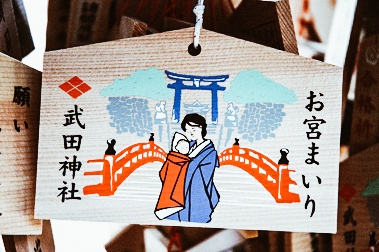

photo credits: japan-photo.de
Le tavolette di legno come forma d’arte
Nel corso dei secoli i disegni delle Ema si sono fatti sempre più elaborati e variegati, dando origine a una vera forma d’arte folkloristica. In particolare le Ō-ema (大絵馬), ovvero “grandi ema”, si sono rivelate un passaggio importante nello sviluppo dell’arte giapponese. Infatti, dopo la nascita delle Ō-ema, diversi saranno i grandi artisti giapponesi che attingeranno allo stile ema.
Nate fra XIV e XVI secolo (periodo Muromachi) tali Ema erano grandi almeno un metro sia in altezza sia in larghezza. Venivano donate a templi e santuari in segno di ringraziamento – anche a posteriori, non solo al momento della richiesta – ed erano collocate in appositi spazi, le Ema-dō (絵馬堂). La più antica Ema-dō sembrerebbe essere stata patrocinata nientepopodimeno che…da Toyotomi Hideyoshi nel 1606, per il santuario Kitano di Kyōto. Sempre a Kyōto poi, anche il famoso Kiyomizu-dera (清水寺) possiede diverse Ō-ema, anticamente donate da dei mercanti come ringraziamento per il ritorno incolume delle loro navi da commercio.
Conseguenza di tale sviluppo artistico fu l’emergere di una “casta” di artisti specializzati nella pittura ema, che trovò massima fioritura nel periodo Edo o Tokugawa. Tale periodo – di espansione economica, specialmente all’inizio – portò infatti la domanda di professionisti a crescere, permettendo loro di campare anche sulla sola realizzazione delle piccole ema.

photo credits: japan-photo.de
Il linguaggio Ema: simbolismo
È proprio in questo periodo che si origina la gran parte di simboli e temi più riprodotti sulle tavolette. Ma a cosa si deve invece tutto questo bisogno di mettere su carta – anzi, su legno – pensieri e sentimenti? Tale bisogno affonda le radici nella credenza folkloristica secondo cui un desiderio ha più possibilità di manifestarsi nella realtà, se viene esternato a parole; poiché, così facendo, gli si dà forma. Dobbiamo inoltre tener presente che in tempi antichi l’alfabetizzazione era riservata a una piccola fetta della popolazione. Un linguaggio alternativo alle parole e immediatamente comprensibile a tutti, si rendeva quindi necessario: è l’incontro fra folklore e simbolismo. Il linguaggio simbolico si rivelò così la via più efficace in tal senso, attraverso la raffigurazione di problemi specifici o della “grazia” desiderata.
Le rappresentazioni potevano spaziare fra diversi ambiti: dal benessere dei bambini, alla salute, alla fertilità, addirittura a desideri circa la sfera sessuale. Se ad esempio un desiderio riguardava un parto, una Ema con la raffigurazione di un cane rappresentava la scelta più appropriata. Mentre l’immagine della volpe bianca ancora oggi indica prosperità e l’abbondanza. Per le richieste riguardanti la salute poi, si soleva anche ritrarre la parte del corpo col malanno. Per quelle invece concernenti fertilità e sessualità, beh: le raffigurazioni erano inequivocabili.

photo credits: himawari-japan.com
Il tipo di rappresentazione può quindi essere prettamente simbolico, attinto dalla tradizione (vedi l’esempio del cane) oppure ritrarre direttamente l’oggetto fisico d’interesse (parti del corpo). Ad ogni modo, ricordiamoci che tale simbologia, analogica o realistica, si accompagna alla funzione taumaturgica delle diverse entità religiose venerate (spiriti/dei/Buddha). Come dicevamo all’inizio, “deità protettrici” di un particolare ambito della vita (salute, istruzione e quant’altro) sono anch’esse un soggetto iconico principe delle Ema. Quelli citati sono solo casi a titolo esemplificativo, poiché soggetti e stili possono essere tanto variegati quanto lo sono le richieste e desideri delle persone.
Il linguaggio Ema: forme e parole
Nel passaggio all’età contemporanea, i temi tradizionali rappresentati non hanno subito grosse variazioni rispetto ai tempi antichi. Naturalmente c’è stata un’aggiunta di nuovi soggetti (vedi Thomas Edison o, perché no, personaggi anime). Possiamo però osservare un aumento del ricorso al linguaggio verbale. Una ragione l’abbiamo già vista: l’alfabetizzazione. L’alfabetizzazione ha così affiancato al linguaggio simbolico quello verbale, consentendo alla gente comune di non dipendere più unicamente dal primo. Allora non è raro ormai il ricorso a giochi linguistici di omonimia e assonanza da affiancare alla simbologia delle immagini.
Tipico è il caso di quelle Gokaku-ema (互角絵馬) – tavolette pentagonali – a tema ‘educazionale’. Esse sono pensate per gli studenti, alla costante ricerca del supporto dei kami per il successo negli studi. Ecco, tali Ema devono la loro forma a una pseudo-omonimia fra l’espressione “gokaku” (互角) – pentagono – e “gōkaku” (合格) che invece indica il successo nello studio. L’argomento dell’Ema può quindi essere trasmesso anche dalla forma stessa della tavoletta! E, come vedete, talvolta può servirsi di significati verbali. Un caso di simbolismo che si serve del linguaggio verbale è invece quello di una Ema ritraente un polpo, “tako” in giapponese (蛸) usata per richiedere ausilio nell’eliminazione dei calli. Il termine “callo” si scrive con caratteri differenti (胼胝) ma si pronuncia anch’esso “tako”.
Possiamo notare quindi – per la gioia di linguisti e glottologi – come il linguaggio ema sia fatto di tutte queste dimensioni della comunicazione. Simboli, forme e parole si integrano così l’uno con l’altro, intrecciandosi, in un unico spazio. Ricordiamoci poi anche che i caratteri grafici della lingua giapponese derivano dagli antenati pittogrammi, che rappresentavano direttamente gli oggetti visivi!

photo credits: blog.livedoor.jp
Il linguaggio verbale risulta molto d’aiuto nell’interpretazione del significato del messaggio di una tavoletta. Poiché capire il vero significato di un linguaggio simbolico, inutile dirlo, può non essere sempre possibile. Ovviamente l’ausilio di quello verbale non garantisce il 100% della comprensione, dipende da caso a caso: possono esserci iscrizioni abbastanza chiare, altre più criptiche. La studiosa Jennifer Robertson, che si è occupata delle Ema al tempo della Seconda Guerra Mondiale, ha riscontrato una particolare ambiguità nelle tavolette di quest’epoca. Motivo per cui, sottolinea la necessità di mettere sempre in conto diverse possibili interpretazioni.
Kogaeshi e Mabiki Ema, un caso particolare
Esiste però un tipo particolare di Ema, dove il messaggio non è né una preoccupazione né un bisogno per qualcosa che si desidera. Una richiesta, sì, ma diversa dalle altre: una richiesta di perdono. Parliamo di tutte quelle targhette che riguardano il caso delicato dei bambini, feti, abortiti o nati morti: i cosiddetti mizuko (水子). Gli Ema riguardanti i mizuko vengono chiamati Kogaeshi (子がえし · lett. “rimandare indietro il bambino”). Oppure anche Mabiki (間引き · chiamiamola “riduzione”) che può riferirsi all’infanticidio generale.
Nei templi buddhisti specializzati sui mizuko (cui vengono dedicati anche memoriali), i Kogaeshi Ema vengono appesi in uno spazio apposito, solo per loro, accanto alla statua del Jizō. Jizō è nel Buddhismo figura protettrice delle anime dei bambini deceduti prima dei genitori. Secondo la credenza, i loro spiriti non possono attraversare il Sanzu – fiume che separa la vita terrena dall’ “Altra Sponda” – poiché non hanno accumulato abbastanza buone azioni, a causa della morte prematura. Sarebbero perciò condannati ad ammucchiare pietre sulla riva del fiume mistico, ma Jizō li proteggerebbe dai demoni e consentirebbe loro di ascoltare i mantra.
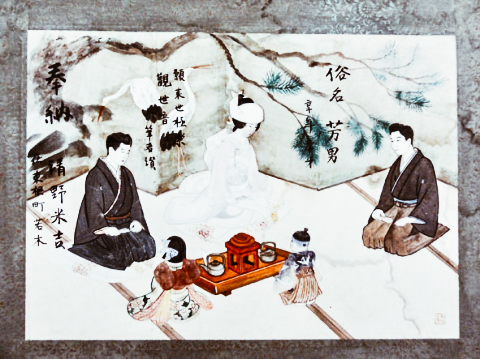
photo credits: hotoke-antiques.com
Si differenziano dalle normali Ema, perché le loro iscrizioni si rivolgono allo spirito del bambino, anziché a kami o buddha. Naturalmente, esprimono tutta l’angoscia, la tristezza, il rimpianto della madre o talvolta anche di entrambi i genitori. L’iscrizione più ricorrente, stando a Reader, sarebbe un semplice “Gomen ne” (ごめんね) ovvero “Mi dispiace” [“Perdonami”] unitamente alla motivazione del gesto. Tale fenomeno ha colpito particolarmente a cavallo fra tardo periodo Edo e inizio periodo Meiji, quando povertà estrema e carestia colpirono duramente la popolazione giapponese. Il ricorso ai Mabiki Ema però è continuato sino ai tempi contemporanei.
Mukasari Ema, altro caso particolare
Altro caso di targhetta legata alla morte, è quello delle Mukasari-ema (ムカサリ絵馬). Queste tavolette infatti nascono per uno scopo singolare: portare a termine i cd. Shirei Kekkon (死霊結婚), i matrimoni fra anime morte. Esse appartengono alla categoria delle grandi ema e, stando alla Robertson, la loro diffusione parrebbe essere circoscritta alla sola Okinawa e al nord-est del Giappone, nella Prefettura di Yamagata. “Mukasari” significherebbe infatti “matrimonio” nel dialetto di Yamagata (non a caso scritto con l’alfabeto katakana). In sostanza tali Mukasari-ema consentono di “simulare” nella rappresentazione della targhetta, il matrimonio di una persona morta da celibe o nubile. È un modo per consentire all’anima di trovare la pace, impedendo che possa divenire uno spirito tormentato.
Se accadesse infatti, lo spirito potrebbe restare ancorato al mondo terreno, attraverso il dolore, per non aver potuto sperimentare la gioia di farsi una famiglia. Quindi, infestare il mondo dei vivi. È così un modo anche per la famiglia della persona deceduta, per quanto fittizio, di realizzare tale sogno. Nei tempi moderni, si può anche ricorrere alle fotografie, se ce ne sono, della persona in abiti nuziali quando ancora in vita. Tali Mukasari-ema sono state particolarmente adoperate ai tempi della Seconda Guerra Mondiale, per il motivo facilmente immaginabile.
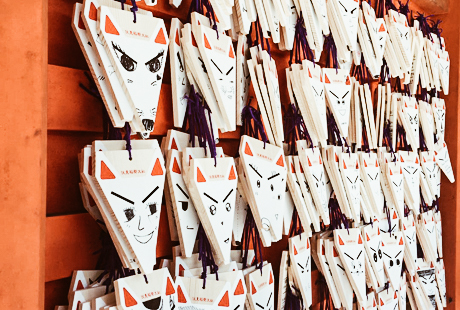
photo credits: journals.openedition.org
Si tratta di due casi limite, l’eccezione alla regola. Poiché come ormai è chiaro, le Ema sono fatte con un occhio al benessere umano, del qui e ora, sia esso individuale o esteso all’umanità intera. Ma sono pur sempre parte del mondo Ema e, se c’è qualcosa che comunque le accomuna alle altre, è una funzione non da poco: quella psicologica, di liberazione da un peso interiore. L’atto stesso di “scaricare” sulle tavolette ciò che si ha dentro – pensieri, desideri, bisogni nonché preoccupazioni – è un atto profondamente catartico. Soprattutto se tali desideri e bisogni vanno in contrasto con le norme imposte dalla società. Come nota Reader, un modo per gli individui di sopravvivere in situazioni che sfuggono al loro normale controllo e unica via di sopravvivenza, dal controllo sociale.
I desideri della gente
Ma in genere cosa desidera nello specifico chi fa ricorso alle Ema? Potremmo individuare due macro-aree: protezione e successo.
Della prima fa certamente parte la salute, tema principe di ogni tempo. Come accennato nell’introduzione, kami e buddha sono associati a poteri curativi, attribuiti per estensione anche a santuari e templi loro dedicati. Le richieste di ‘grazia’ da malanni e malattie – o di protezione preventiva da qualsivoglia pericolo – possono riguardare il richiedente stesso, i suoi familiari, oppure altre persone. Le richieste riguardanti il successo, ambito molto sentito, possono anch’esse riguardare il richiedente o terzi oppure un ‘io collettivo’ di cui il richiedente fa parte. È il caso di tutte quelle richieste fatte per propiziare il successo della propria azienda o istituzione di qualsiasi altra natura. Vi sono Ema ad esempio dove il richiedente si preoccupa del successo della propria squadra del cuore (in Giappone molto popolare è il baseball).
Ma c’è un reame che emerge in modo particolare su tutti quanti: l’istruzione. Il sistema educativo giapponese contemporaneo è molto rigido e competitivo, e la pressione dell’insuccesso sui ragazzi può essere particolarmente gravosa, dal punto di vista psicologico. Allora, vuoi già solo per questo motivo. Vuoi anche per ispirazione – nel vedere amici o gruppo di coetanei recarsi nei centri religiosi a scrivere le loro targhette – fatto sta, che gli studenti rappresentano una bella fetta di “clientela” per le Ema. Oltre a richiedere il favore “dei cieli” nella buona riuscita di test ed esami, l’iscrizione delle Ema può rappresentare per i giovanissimi un momento di leggerezza, di spensieratezza.
Come non menzionare a questo punto il kami shinto Tenjin (天神), patrono della cultura e dell’istruzione, certamente popolare fra gli studenti giapponesi. (Per altro, Tenjin è la deificazione di una persona realmente esistita fra IX e X secolo d. C.! Letterato e politico di corte Heian, in vita il suo vero nome fu in realtà Sugawara no Michizane.) I suoi santuari sono i più frequentati nei mesi freddi, soprattutto gennaio e inizi febbraio, quando ha luogo il famigerato “inferno degli esami di ammissione”.
Non mancano poi certamente richieste riguardanti benessere materiale così come quelli riguardanti gli affari di cuore. Addirittura quelle per “recidere i legami” con l’ausilio delle apposite Enkiri-ema (縁切り) per esprimere il desiderio di spezzare il cordone che lega a persone, cose (vizi, dipendenze) o situazioni (malattie).
L’incinerazione delle tavolette
Eh sì, questa è una tappa importante della vita delle tavolette: quella finale. Sia i santuari shinto sia i templi buddhisti periodicamente provvedono a bruciare le tavolette offerte, a duplice scopo: rituale ma anche pratico. (Nella religiosità giapponese dimensione pratica e dimensione spirituale riescono a sposarsi serenamente). La motivazione pragmatica è dovuta semplicemente…alla necessità di fare spazio! Dopotutto, centinaia e centinaia di tavolette nel tempo si accumulano.
La motivazione spirituale invece vuole che, attraverso il rito del falò, desideri e richieste delle persone possano giungere al regno dei kami e dei buddha. Kami e Buddha che, vi ricordo, dovrebbero comunque aver già letto le Ema, sempre a disposizione in templi/santuari, prima dei rituali del fuoco. Ancora una volta Noragami ci viene in aiuto, con la sua storia così esemplificativa. Non è raro infatti vedere proprio il Tenjin aggirarsi nei santuari lui dedicati, di fianco le tavolette Ema. In Noragami, per altro, si tocca anche il tema del recidere i legami, di cui abbiamo parlato poc’anzi (insomma, avete capito l’antifona: guardatelo/leggetelo).
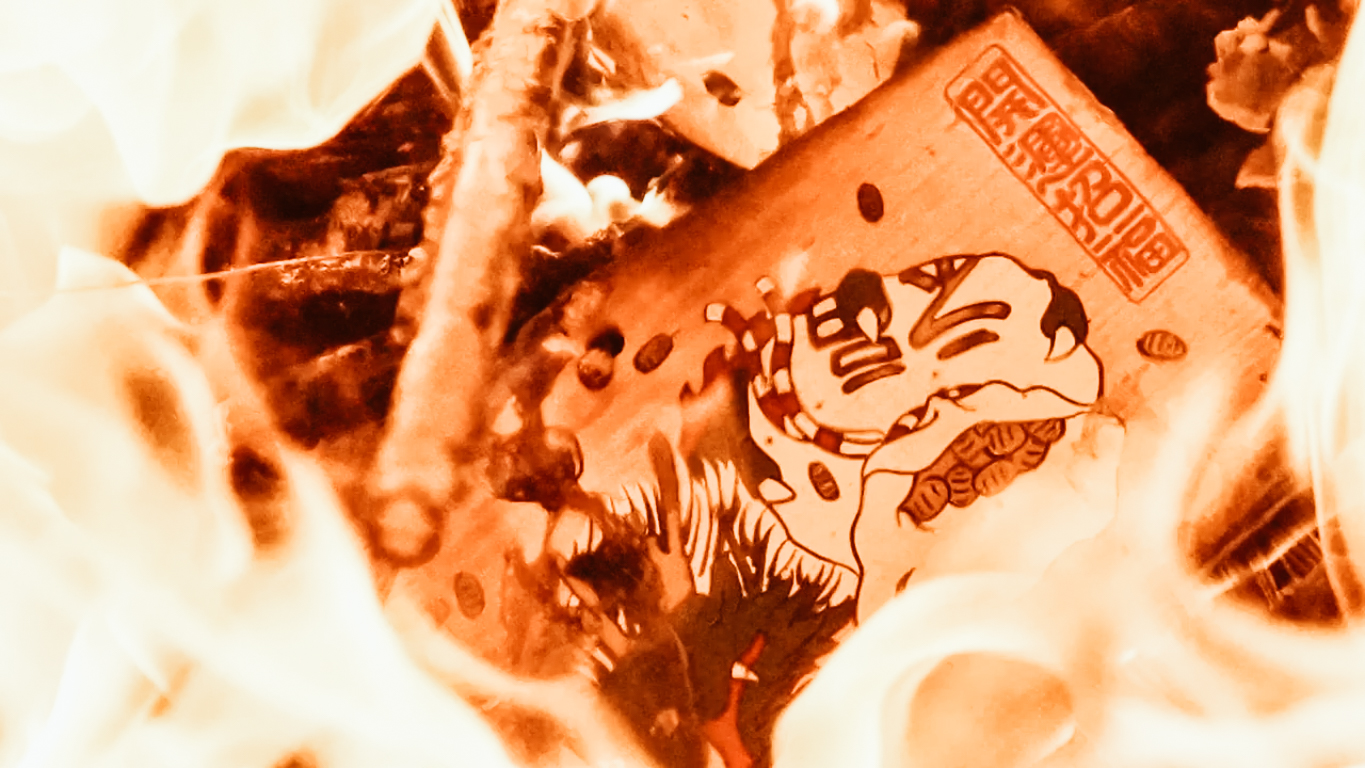
photo credits: https://youtu.be/Vn6AoThrXyc
Quando si svolge tale rituale?
Il passaggio al nuovo anno è il momento che mette tutti d’accordo. Tuttavia può avvenire anche in altri periodi, diversi a seconda di ogni centro religioso. I santuari di Tenjin ad esempio sono soliti farlo a fine ottobre, appena dopo i festival a lui dedicati.
Il periodo attorno al Capodanno, l’O-Shogatsu (お正月), è tuttavia l’ideale per tutti, essendo un momento di transizione. Quale momento migliore per rilasciare simbolicamente ciò che ormai ha fatto il suo tempo, liberando desideri e richieste del vecchio anno? E allo stesso tempo, quale momento più propizio per inaugurare l’anno nascente, magari scrivendone di nuovi? Ammazza, quante commissioni per questi kami e buddha già dai primi sospiri del nuovo anno! La frase “Liberarsi del vecchio per far spazio al nuovo”, in questo contesto, non può che calarsi bene, prestandosi più che perfettamente a tale interpretazione duale.
Nulla piove dal cielo!
Attenzione però, a non fraintendere. Non pensiate che si tratti di un mero atto di superstizione: niente di più lontano dalla realtà! Ricorrere alle Ema non equivale a pensare di mettersi a braccia conserte, aspettando una grazia ultraterrena. Chi ricorre alle Ema, generalmente sa bene, anche con un ipotetico “favore dei cieli”, che il 95% delle probabilità di successo sono date dal proprio impegno. E dal proprio atteggiamento mentale. Mi riferisco naturalmente a tutte quelle situazioni dove uno ha potere d’azione. Nei casi in cui ciò non sia possibile, l’unica cosa da fare è cercare di agire, il più che si riesce, sul proprio atteggiamento mentale.
Le tavolette Ema testimoniano la ricerca di un cambiamento o di sicurezza da qualche rischio o pericolo. Hanno la facoltà di avvicinare anche i più “laici”, coloro che magari non fanno una grande vita spirituale. Come può essere il caso di diversi giovani, o dei bimbi, che possono cogliere nelle tavolette anche un lato giocoso, oltre che di supporto per gli studi. Il senso dell’offrire una tavoletta Ema è sostanzialmente quello di far fronte a una crisi, di qualsiasi natura, ricorrendo alla dimensione soprannaturale, da sempre fonte di supporto. In altre parole, le Ema svolgono una funzione di conforto e di sostegno. E, di riflesso, un’importante funzione terapeutica.














